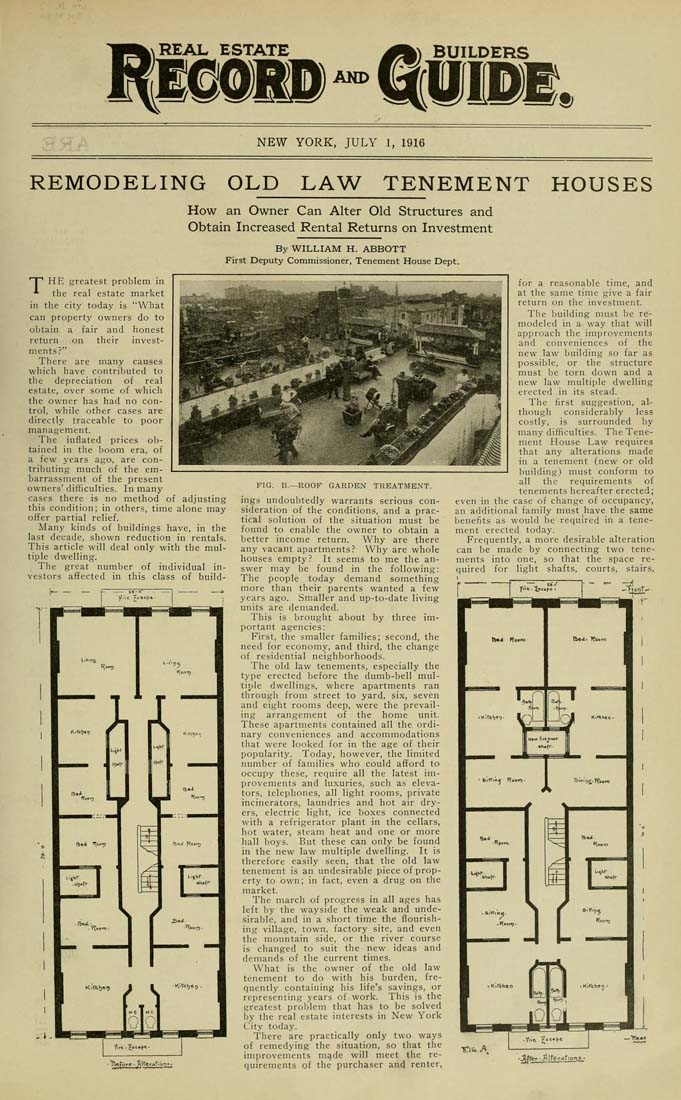Please note: this text may be incomplete. For more information about this OCR, view
About OCR text.
REAL ESTATE
AND
NEW YORK, JULY 1, 1916
REMODELING OLD LAW TENEMENT HOUSES
How an Owner Can Alter Old Structures and
Obtain Increased Rental Returns on Investment
By WILLIAM H. ABBOTT
First Deputy Commissioner, Tenement House Dept.
np HE greatest problem in
■*• the real estate market
in tlie city today is "What
can property owners do to
obtain a fair and honest
return on their invest¬
ments?"
There are many causes
which have contributed to
the depreciation of real
estate, over some of which
the owner has had no con¬
trol, while other cases are
directly traceable to poor
management.
The inflated prices ob¬
tained in the boom era, of
a few years ago, are con¬
tributing much of the em¬
barrassment of the present
owners' difficulties. In many
cases there is no method of adjusting
this condition; in others, time alone may
oflfer partial relief.
Many kinds of buildings have, in the
last decade, shown reduction in rentals.
This article will deal only with the mul¬
tiple dwelling.
The great number of individual in¬
vestors affected in this class of build-
■ 'Htetbre ■ l\iter»1'ion'"
FIG. B.—ROOF GARDEN TREATME.NT.
ings undoubtedly warrants serious con¬
sideration of the conditions, and a prac¬
tical solution of the situation must be
found to enable the owner to obtain a
better income return. Why are there
any vacant apartments? Why are whole
houses empty? It seems to me the an¬
swer may be found in the following:
Tlie people today demand something
more than their parents wanted a few
years ago. Smaller and up-to-date living
units are demanded.
This is brought about by three im¬
portant agencies:
First, the smaller families; second, the
need for economy, and third, the change
of residential neighborhoods.
The old law tenements, especially the
type erected before the dumb-bell mul¬
tiple dwellings, where apartments ran
through from street to yard, six, seven
and eight rooms deep, were the prevail¬
ing arrangement of the home unit.
Tliese apartments contained all the ordi¬
nary conveniences and accommodations
that were looked for in the age of their
popularity. Today, however, the limited
number of families who could afford to
occupy these, require all the latest im¬
provements and luxuries, such as eleva¬
tors, telephones, all light rooms, private
incinerators, laundries and hot air dry¬
ers, electric light, ice boxes connected
with a refrigerator plant in the cellars,
hot water, steam heat and one or more
hall boys. But these can only be found
in the new law multiple dwelling. It is
therefore easily seen, that the old law
tenement is an undesirable piece of prop¬
erty to own; in fact, even a drug on the
market.
The march of progress in all ages has
left by the wayside the weak and unde¬
sirable, and in a short time the flourish-
in.g village, town, factory site, and even
the mountain side, or the river course
is changed to suit the new ideas and
demands of the current times.
What is the owner of the old law
tenement to do with his burden, fre¬
quently containing his life's savings, or
representing years of work. This is the
.greatest problem that has to be solved
by the real estate interests in New York
City today.
There are practically only two ways
of remedying the situation, so that the
improvements made will meet the re¬
quirements of the purchaser and renter,
for a reasonable time, and
at the same time give a fair
return on the investment.
The building must be re¬
modeled in a- way that will
approach the improvements
and conveniences of the
new law building so far as
possible, or the structure
must be torn down and a
new law multiple dwelling
erected in its stead.
The first suggestion, al¬
though considerably less
costly, is surrounded by
many difficulties. The Tene¬
ment House Law requires
that any alterations made
in a tenement (new or old
building) must conform to
all the requirements of
tenements hereafter erected;
even in the case of change of occupancy,
an additional family must have the same
benefits as would be required in a tene¬
ment erected today.
Frequently, a more desirable alteration
can be made by connecting two tene¬
ments into one, so that the space re¬
quired for light shafts, courts, stairs,
^.[c.A
■ 3f SLj?! liSiftil25i."








